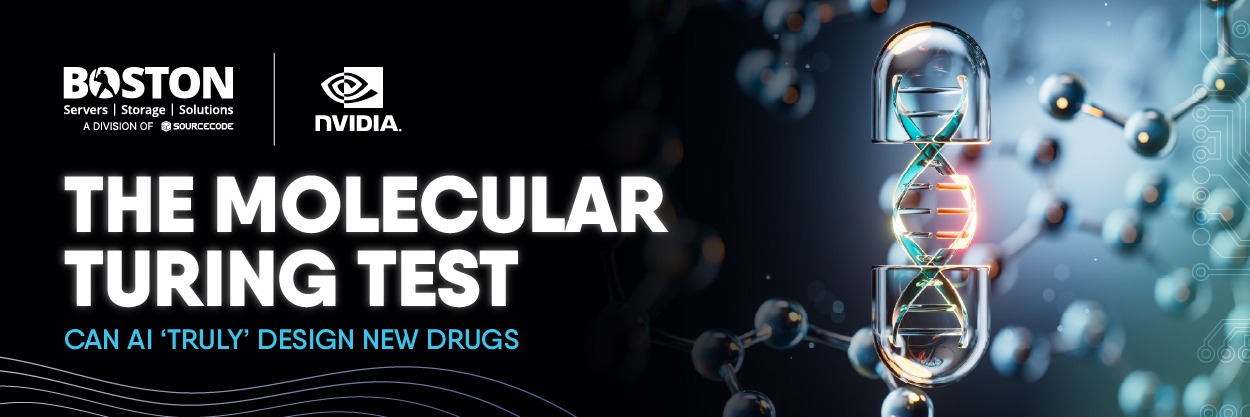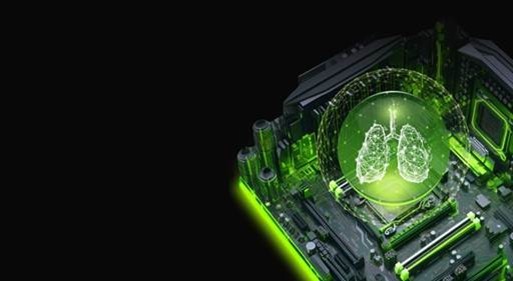
In a world where algorithms generate symphonies, paintings and even conversations, the frontier of creativity has shifted – now, it reaches into the molecular heart of life itself. Today’s most advanced AI systems don’t just process data; they design entirely new molecules, unseen in nature, with the potential to treat cancer, reverse fibrosis or halt neurodegeneration. This is the dawn of generative chemistry – and it's powered by AI that learns the rules of chemistry, imagines new possibilities and accelerates drug discovery at speeds once thought impossible. But with great power comes a defining question:
When should we trust these AI-designed molecules?
Like Alan Turing’s famous thought experiment for machine intelligence, generative chemistry now faces its own test – a test of trust, creativity and clinical truth.
At the centre of this transformation is a convergence of disciplines: quantum principles, deep neural networks and NVIDIA’s AI computing infrastructure. From NVIDIA DGX™ supercomputers to NVIDIA BioNeMo™ molecular models, a new kind of ‘AI factory’ is emerging in pharma labs across the globe. These platforms are not just helping us discover drugs faster. They are challenging the very idea of what it means to ‘discover’ at all.
In this article, we explore the technological and philosophical revolution unfolding in front of us. We’ll ask what it really means for a machine to design a drug – and how we can build the trust needed to bring that drug from silicon to bedside.

Figure: NVIDIA GPUs and advanced AI modelling converge to accelerate molecular discovery (illustrative). Generative AI can explore billions of chemical structures, enabling rapid design of novel drug candidates (1).
Generative chemistry depends on scale. Training and running today’s large molecular models requires massive parallel computing. NVIDIA’s accelerated computing platforms – from NVIDIA DGX SuperPODs™ to Grace™ CPUs and HGX™ servers – are at the core of AI factories that industrialise drug discovery (2). These AI factories combine supercomputers (like Denmark’s Gefion DGX SuperPOD) with optimised software (such as NVIDIA’s BioNeMo and NeMo™ frameworks) so researchers can deploy advanced models for protein folding, virtual screening, docking and molecule generation at scale. As one NVIDIA press release explains, Gefion, powered by NVIDIA DGX SuperPOD, “provides Novo Nordisk an AI factory for running drug discovery and agentic AI workloads,” enabling custom generative models, massive simulation and even virtual lab environments (3). In practice, pharma teams can queue up jobs on a DGX SuperPOD to train a biomolecular transformer or run millions of docking simulations in hours instead of months.
But raw compute isn’t enough on its own. Generative chemistry requires ultra-fast, high-bandwidth networking to connect these AI factories into truly collaborative discovery engines. Moving terabytes of genomic sequences, Cryo-EM reconstructions and molecular dynamics simulations between teams and sites demands an interconnect fabric as advanced as the GPUs themselves. Technologies like NVIDIA Quantum-2 InfiniBand™ and NVIDIA Spectrum-X Ethernet™ deliver the low latency and throughput needed to keep distributed models, simulations and data pipelines in sync, enabling researchers on opposite sides of the globe to work as if they were sharing a single lab bench. In effect, networking becomes the nervous system of AI-driven discovery, ensuring that insight travels as quickly as imagination.
NVIDIA’s BioNeMo platform is a core component of generative biology workflows, offering APIs and AI microservices that can be deployed in both cloud and on-premises environments. It provides pretrained large language models and diffusion models for molecular generation, property prediction and protein-ligand interactions, enabling seamless integration into computational pipelines for drug discovery and structural biology (2)(3).
It offers an accessible entry point for both experts and non-specialists to interact with powerful biomolecular AI generative models. Through interactive interfaces and APIs, users can input sequences (e.g., UniProt IDs), run structure prediction workflows using tools like NVIDIA AlphaFold2™ and visualise folded proteins in real time. For more advanced use cases, NVIDIA NIM™ (Nvidia Inference Microservices) provides production-ready, containerised services for de novo molecular generation, ADMET property prediction, drug repositioning, protein binder design and generative virtual screening. These NIMs can be deployed across cloud, on-premises or hybrid environments and are optimised for inference within accelerated computing stacks such as NVIDIA DGX, NVIDIA RTX™ and Grace Hopper systems. In addition, BioNeMo Blueprints enable faster development of end-to-end generative AI workflows in drug discovery by offering reusable templates for tasks like protein design and molecular optimisation. Integrated with the NVIDIA AI Enterprise ecosystem – alongside tools such as NeMo Guardrails, cuVS, MONAI and third-party platforms like Schrodinger, OpenEye and Dataiku – BioNeMo provides a modular and customisable foundation for deploying scalable AI pipelines in pharma R&D (3).
Key Components of the Generative Chemistry Stack (4):
- NVIDIA BioNeMo Framework & Microservices: Pretrained biomolecular LLMs and generative models, with cloud APIs for protein folding, molecule docking and molecule generation.
- NVIDIA DGX SuperPOD™ / Grace™ CPU / HGX™: Supercomputers and CPUs purpose-built and optimised for AI, enabling giga-scale training and inference of models.
- NVIDIA Omniverse™ & Physics Simulation: 3D virtual labs and digital twins for testing molecules in silico with realistic physics.
- Agentic AI Workflows: NVIDIA’s AI toolkits (e.g. BioNeMo and NIM microservices) let researchers build agent-based pipelines that can autonomously propose, score and iterate on compounds, guided by scientific objectives.
Alan Turing asked whether a computer could convince a human it was another person. In chemistry, an analogous question arises: can AI-generated molecules convince scientists that they are no less viable than human-designed ones?
Some researchers have started to frame a Molecular Turing Test to probe this. In one study, medicinal chemists were shown a mix of molecules: some ideas drawn from human experts and others generated by algorithm. The chemists rated hundreds of structures “like” or “dislike” without knowing their source. Remarkably, the best-performing generators produced ideas that chemists found just as compelling as their own. As the authors note, the test was “inspired by the Turing test”: by combining human and computer ideas, they measured whether algorithmic designs were competitive with human ingenuity (6).
Of course, passing the appearance Turing Test is not enough. In chemistry we need objective proof. Even if a compound looks good on paper, only experiments can confirm its promise. In that sense, the real Turing Test for generative chemistry is empirical: can an AI-designed molecule go through synthesis, assays and trials to become a drug? So far, the indicators are encouraging. NVIDIA’s partner Insilico reports that its lead AI-designed compounds achieved “unprecedented success rates” in preclinical testing (1). They designed ~80 molecules with their AI engine and quickly identified one with high potency and a clean safety profile. Novartis and Exscientia similarly advanced AI-generated drugs into clinical trials (7).
We are at the brink of soon viewing AI not as a novelty but as a standard R&D tool, its designs judged by clinical outcome rather than origin. The ideal future is a seamless human-AI partnership: generative models expand our creative horizon, and scientists apply their expertise and ethics to keep them grounded. As Insilico’s CEO put it: developing an AI-designed fibrosis drug into Phase II trials is “a true validation of our generative AI platform” (5).
Looking ahead, we can imagine AI agents that continuously learn from new experiments (an “AI chemist-in-the-loop”) and entirely new modalities of design (e.g. combining small molecules and biologics in hybrid therapies). NVIDIA’s vision of “physical AI” hints at one direction: using robotic labs and simulation to autonomously execute candidate molecules. But crucially, human oversight remains vital. AI can propose, but scientists must interrogate and refine. The goal is not to replace chemists, but to empower them – to make the ‘impossible’ within reach and let human insight focus on innovation and compassion.
In the end, the generative chemistry Turing Test is both technical and philosophical. Technically, it demands that AI-designed compounds meet the same rigorous proof-of-concept milestones as any drug. Philosophically, it challenges us to see creativity beyond the human mind: if a cure is discovered in silicon and purified in a lab, does it matter who ‘imagined’ it?
When an AI-designed medicine stands beside human-designed medicines in the clinic, we will have our answer: the Turing Test will be passed, and a new era of cooperative intelligence in drug discovery will begin.
As we move toward a future where AI doesn't just assist but co-creates the next generation of therapies, the infrastructure behind that intelligence becomes as vital as the models themselves. Boston Limited, as a long-standing NVIDIA Elite Partner, plays a crucial role in this evolution, delivering the high-performance computing systems, AI-ready architecture and bespoke deployment expertise that turn possibility into practice. Whether it's enabling AI factories for generative chemistry or supporting real-time molecular simulation pipelines, Boston empowers researchers, biotech firms and pharmaceutical giants to harness their full potential.
In this age of accelerated discovery, trust in AI begins with trust in the systems that power it – and Boston Limited stands at the foundation of that trust, helping scientists transform molecules into medicines and ambition into action.
Author
Lekha Pantula
Senior Campaign Executive
Boston Limited